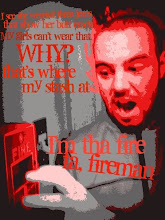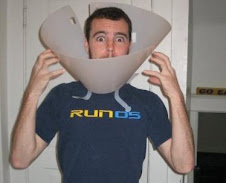As I'm sure many of you have now either seen Wes Craven's second take of horror film Last House on the Left, or you've heard enough buzz to formulate reason's to skip out on 2009's double Friday 13th release. Either way, the following is a brief review of the film from a "by no means" professional critic, but from an avid horror-goer...
There have been many reviews commenting on the 2009 "remake" of Last House on the Left. To start off, let's point out some of the consistent inconsistencies between the original 1972 flick, and that of present day. The "original" - (and original is used in a rather loose presence as many claim the 2009 picture is in fact not a remake, although anyone who has seen either film can attest to its historical/borrowed nature) - depicts two teenage females, Mari Collingwood and friend Phyllis Stone embarking on a trip to see favorite band Bloodlust. The show is in celebration of Mari's 17th birthday, and becomes the catalyst at which a gang of rapist/murderers indulge in their next victims. While awaiting the show Mari and Phyllis are kidnapped as they try to score some pot before the band takes stage. While entrapped by the so-called criminals, Mari is forced to witness the rape of Phyllis, and the two are then locked in the trunk of the car which will eventually break down in front of Mari's house - unbeknownced to the killers. . . Finally, as I'm sure you can infer, the film turns into a rage-infested, fight-for-your-life "revenge-flick" as the Collingwood parents realize the strangers they harbor within their own home are the cause for the disappearance of their beloved daughter; a detail discovered by a peace-charm necklace Mari was wearing at the time of her departure that had been placed in the home by Junior, the son of the criminal "gang" leader. The rest is history, as the Collingwood parents seek revenge upon the group, murdering them one-by-one (Sadie, Junior, Krug & Weasel) - turning the film into the ultimate "good-triumphs-evil" terror film.
In the latest version (2009) the Collingwood family travels to their secluded lake house for vacation one year after their son's death. However, this time the two young females, Mari and Paige (Phyllis '72), become the innocent victims of a similar gang of criminals after, much like the original. The two teenagers are caught with Krug's son Justin (Junior '72) in their motel room after previously murdering two police officers. It was the unfortunate miscalculation of Krug and the gang's return by Justin that led to the indefinite surmise of Paige and Mari. Like the original, Paige and Mari traveled to the motel room with Justin in order to "score" some pot. The repeated attempts to escape Krug, Francis (Weasel '72) and Sadie end in Paige's murder and Mari's rape. However, Mari manages to get away and miraculously swim back to her lakehouse after being shot. Feeling responible for the two girls' resulting situation, Justin finds it almost unbearable when he realizes they have saught refuge at the Collingwood residence as in the 1972 version. Justin alerts the Collingwood parents in similar fashion to that of Junior, by leaving a gold pendant wrapped around his hot-chocolate mug in the home's kitchen. This pendant is significant as Mari was wearing it when she departed for Paige's. Once again the family seeks revenge (with the help of remorseful Justin) and kills each member of the gang individually before leaving the house by boat.
After-thoughts -
The main reason for writing this entry was to critique the movie, so here it is... One of the most pivotal scenes in the current version of the film lies within its first 20 minutes. As Mari is raped by the gang leader Krug, the directors leave out no, and I mean NO details. The entire scene is displayed on screen, start to finish, graphic, violent, terrorizing, nightmareish, and any other descriptive word one can think of. This leaves viewers, including myself, asking the following questions - 1. How much is too much? - 2. When does the MPAA (CARA) set more harsh regulations on film ratings? - 3. When is an 'R' rated movie, more than just an 'R' rated movie?
1.) The rape of a 17 year old girl, on any screen, is too much to be shown publicly. One may argue that if one purchases tickets to a film of their choice, they bear their own risk and discomfort of what may be displayed on the screen. However, when the common norm for rape scenes in publicly shown films - if there is such a thing - is "out-done" by a new flick, the viewer may have no idea what they are getting themselves into. Witnessing the complete rape of a 17 year old girl was the most disturbing thing I have ever seen in my entire life. Could I have left the theatre and asked for a refund? Sure. However, that does not provide a solution to what should and should not be allowed in theatres nationwide. And for those who have viewed the original, when rape was hardly shown in movies at all, would have no idea what to expect. Yes, 37 years difference brings changes of liberation to what's allowed on television, radio, and in cinematography - but those original fans got more than they bargained for, especially knowing the original directors had a hand in the 2009 remake.
2.) At some point the MPAA (CARA) and ratings committees MUST decide when to employ tight regulations on films. I am a fairly liberal individual, an avid horror movie fan, and all for freedom and rights in this great country. However, the showing of an entire rape start-to-finish of a 17 year old teenager is where a BOLD line should be drawn on film regulations. Not saying that showing the rape of a 40 year old woman on screen would be any better, but showing scenes like tin Last House on the Left have a far more profound impact on viewers, especially those younger than the 17 yr. minimum to view 'R' rated movies --- and this brings up another point, at what age should one be able to view such horrific scenes? In the showing I attended, there at least six children between the ages of 11-14 who's parents bought them tickets (hopefully having no idea what they were about to see). The only thing saving these kids is the fact that some may have been too young to really comprehend what was actually happening, while others (especially males) should not be exposed to such content until able to cognitively breakdown and understand what's going on atop the big bright screen. Scenes like the rape scene of this film should be removed, as it turns the movie from a good suspenseful horror flick, into a showing of pure terror at which most viewers leave in disgust.
3.) 'R' movies are one thing, 'R' movies. They may display gross sexual conduct, nudity, profane language, sexual content, sexual language, drug use, you get the picture... The MPAA states: "An R-rated motion picture may include adult themes, adult activity, hard language, intense or persistent violence, sexually-oriented nudity, drug abuse or other elements, so that parents are counseled to take this rating very seriously." Their reasoning for the 'R' rating in Last House on the Left is as follows: " Rated R for sadistic brutal violence including a rape and disturbing images, language, nudity and some drug use." The words "sadistic brutal violence including a rape" should never be acceptable criteria for a publicly viewed 'R' rated film. The rating system is in fact voluntary, therefore no law can be put in place to legally "enforce" regulations on 'R' rated films. Looking back to the 1996 horror film Scream for a loose (Yes I said loose) comparison: "The film Scream was originally rated NC-17 for "graphic horror violence and gore" but under appeal by director Wes Craven, it was changed to R with some overly graphic content cut out." - In looking at the content between the originally NC-17 rated movie Scream and the MUCH MORE graphic LHOTL, there are obvious inconsistencies in United States film ratings.
Contagion!
15 years ago









No comments:
Post a Comment